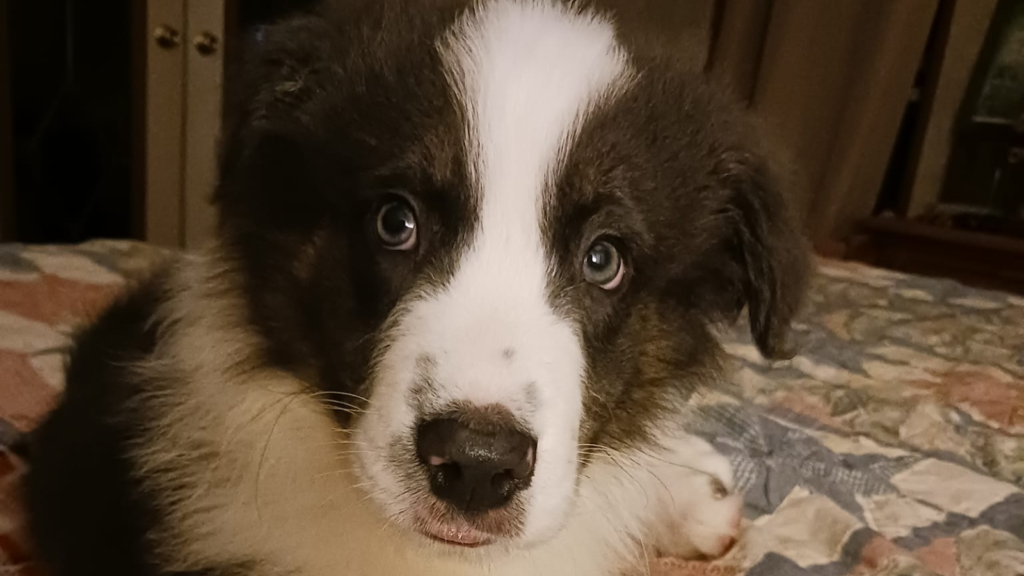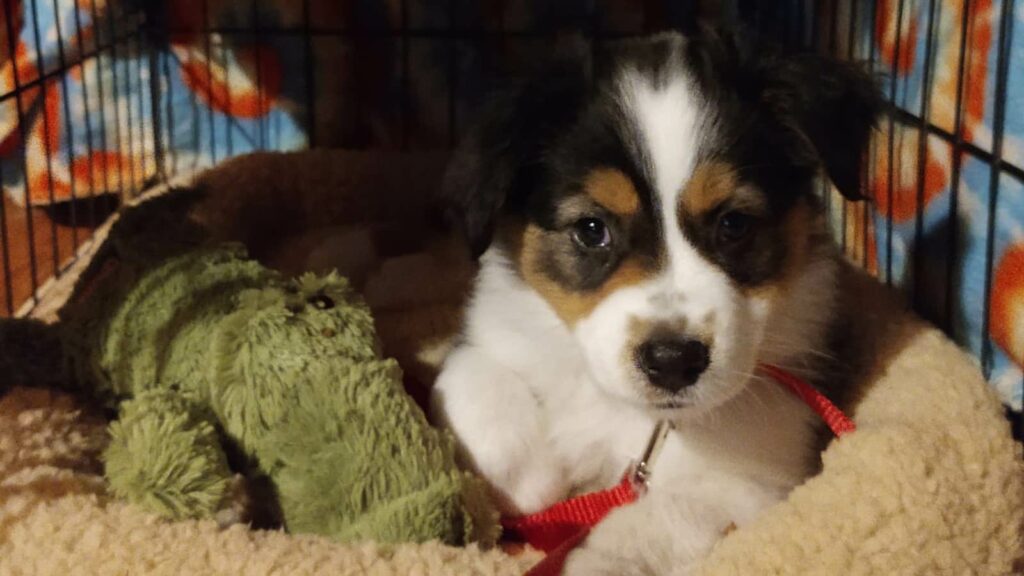If you are familiar with Australian Shepherds, you probably already know what a great breed they are and that they are one of the most popular among dog owners.
Although Australian Shepherds are one of the best breeds around, one common issue among Aussie owners is that they struggle because this breed is not hypoallergenic.
Have you ever wondered what would happen if you mixed an Australian Shepherd with a hypoallergenic breed?
If you are curious to learn more about what a hypoallergenic dog is, and what happens when you mix an Australian Shepherd with a breed of this type, keep reading to find out more!

What is a Hypoallergenic Dog?
Before we get into talking about Australian Shepherd hypoallergenic mixed breeds, let’s talk about what exactly “hypoallergenic” means.
A dog that is hypoallergenic means that it is not likely to cause allergic reactions. These dogs have less fur and dander (like dandruff/tiny pieces of dead skin) that can cause irritation and allergies.
Disclaimer: This post may contain affiliate links. We only recommend high-quality products that are used and recommended by real owners. If you use these links to buy something we earn a small commission.
Unfortunately, there is no dog breed that is fully hypoallergenic because all breeds produce some type of dander, even hairless dog breeds. There are, however, dogs that produce a very low number of allergens; owners with these breeds usually do not have any allergy issues.
Dogs that are single-coated are known to produce the least number of allergens. Some dogs that have single coats include Poodles, Yorkshire Terriers, Cocker Spaniels, Basset Hounds, etc.
It is important to note that not only can a dog’s dander and fur cause allergens, but also their saliva and urine (hint: this is why even hairless breeds can still cause allergies!)
This is also good to remember especially if you own a breed that is known for producing a lot of saliva (Example: St. Bernards and Bulldogs).
NOTE: It is important to potty train your dog early so that there won’t be any urine left on surfaces in the house, especially carpet. This is oftentimes an issue for those who suffer from allergies caused by dogs — fur and dander can also become trapped in carpet!
Overall, trying to get a dog that produces the least amount of dander and who doesn’t shed a lot is the best option for people that suffer from allergies. Both of these factors are what usually cause the most intense allergies.
Are Australian Shepherds Hypoallergenic?
Some people are not aware that there are not very many dogs out there that are hypoallergenic. One common misconception is that Australian Shepherds are hypoallergenic.
Purebred Australian Shepherds are not hypoallergenic, they tend to have a lot of fur, need consistent grooming, and produce high amounts of dander.
Because Aussies are double-coated dogs, they produce even more hair, which is not good for people who suffer from allergies.
It is important to remember that a lot of times a dog’s fur isn’t what is causing people to have allergies, it is the dander that comes off their skin and lands on surfaces that people then breathe in.
Because Australian Shepherds shed a lot, their dander can spread throughout a living space very quickly, which can then cause people living in that space to experience allergy symptoms.
If you are thinking about getting an Australian Shepherd, it is important to consider that they are not a hypoallergenic breed. Thankfully, there are many breeds that are hypoallergenic that Aussies can be bred with to create an Australian Shepherd hypoallergenic mix.
NOTE: An Australian Shepherd will usually shed even worse during the springtime because they are losing their winter coats.
People who are familiar with Australian Shepherds often wonder if the Mini Australian Shepherd is hypoallergenic seeing as the full-size Aussie is not.
Unfortunately, Mini Aussies are not hypoallergenic either; they have the same skin and fur type as a regular-sized Aussie and shed the exact same.
Anyone who has experienced allergies from a regular-sized Aussie will experience allergies from a Mini Aussie as well.

What Australian Shepherd Mixes are Hypoallergenic?
Since Australian Shepherds are so popular, people who want an Aussie mix that is also hypoallergenic are in luck! There are many purebred hypoallergenic breeds that can be mixed with Australian Shepherds.
Some of the most popular Australian Shepherd hypoallergenic mixes include the Aussiedoodle (Aussie/Poodle), Aussietare (Aussie/Terrier), and Aussiechon (Aussie/Bichon Frise).
There are a lot of different Aussie mixes out there, here are a few mixes that are the most common for people with allergies to own, usually because these dogs either won’t cause any allergies or will significantly lessen a human’s chance of developing allergies:
- Schnauzer Australian Shepherd Mix
- Aussiechon (Australian Shepherd/Bichon Frise Mix)
- Aussiedoodle (Australian Shepherd/Poodle Mix)
- Terrier Australian Shepherd Mix (most common is the Bull Terrier/Aussie mix)
- Auss Tzu (Australian Shepherd/Shih Tzu Mix)
- Maltese Australian Shepherd Mix
- Havanese Australian Shepherd Mix
Most all dog breeds that are considered hypoallergenic can be mixed with an Australian Shepherd, here are some of those breeds:
- Miniature Schnauzer
- Poodle
- Yorkshire Terrier
- Shih Tzu
- Maltese
- Portuguese Water Dog
- Scottish Terrier
- Giant Schnauzer
- West Highland White Terrier
- Cairn Terrier
- Bichon Frise
- Havanese
There are also some short-haired breeds that will be mixed with Australian Shepherds even though they are not considered hypoallergenic; however, these dogs are still great for dog owners because they will shed way less and produce less dander than other breeds.
Some of these Australian Shepherd mixes include the Auberman (Aussie/Doberman), Australian Retriever (Aussie/Golden Retriever), and the Aussie Pit (Aussie/Pitbull).
There are so many other different breeds out there that Australian Shepherds can be mixed with, let’s break it down into whether they are likely or not to cause allergic reactions:
Breed mixed with Australian Shepherd | Cause Allergies? |
Border Collie | Yes – High shed/Dander + Double-Coat |
Corgi | Yes – High shed/Double-Coat |
Husky | Yes – High shed/Double-Coat |
Labrador Retriever | Yes – High shed/Double-Coat |
German Shepherd | Yes – High shed/Double-Coat |
Beagle | No – Low shed/short fur |
Rottweiler | No – Low shed/short fur |
Chow Chow | Yes – High Shed/Double-Coat |
Jack Russell Terrier | Yes – High shed/Dander + Double-Coat |
It is important to remember that when mixing two different dog breeds, the results can sometimes be unexpected.
Although it isn’t likely, after mixing an Australian Shepherd with a low-shed or hypoallergenic dog, they may end up shedding just as much as a pure-bred Australian Shepherd.
This can happen if the mixed puppy is born with more of the Australian Shepherd genes than those of the hypoallergenic dog that it is being mixed with.
NOTE: If an Australian Shepherd Hypoallergenic mix puppy is born with fur very similar to an Aussie, don’t worry! While the puppy could have similar hair, they may not shed as much or have as much dander if their skin takes after their other, hypoallergenic parent breed.

Am I Allergic to my Australian Shepherd Mix?
If you have ever owned a dog that is known to cause allergies and you are susceptible to those allergies, you probably know how easy it is to tell when you’re having a reaction.
There are many ways to tell if you are having an allergic reaction to your Australian Shepherd Mix, even if the signs aren’t super obvious. Some things you might notice are a runny nose, itchy skin, red eyes, or bumps/hives.
People who have severe reactions to dog fur, dander, saliva, etc. may experience congestion, skin rash, and even trouble breathing.
Thankfully, there are many things you can do if you are still experiencing allergies even if you own or are often near a hypoallergenic Aussie mix or another low shed/low dander dog. Here are a few tips:
- Vacuum your house consistently — This gets rid of the hair and dander that settle onto surfaces like the floor, tables, couches, etc.
- Groom and bathe your Aussie mix consistently — By grooming and especially brushing, you can eliminate any fur that may end up falling out onto the floor, bathing your Aussie mix can rid them of any dander that is building up on their skin.
NOTE: If you are interested in learning more about Australian Shepherd grooming, check out this article: Australian Shepherd Hair Care (Complete Grooming Guide!)
- Keep your dog off any furniture — Some dog owners suggest keeping your dog out of rooms you spend a lot of time in and also keeping them off of your furniture. This will usually help to eliminate any fur or dander resting on those surfaces that you are near so often.
TIP: If you do let your dog on the bed or couch, be sure to wash the sheets consistently, or lay a washable blanket over your couch to protect it!
- Consider switching to hardwood flooring — If your current living space has a lot of carpet, it is likely that your dog’s fur and dander is being pushed deeper into the carpet, making it harder to rid of it simply by vacuuming. Having hardwood flooring has been known to help a lot of pet owners who suffer from allergies.
- Use an air purifier — Air purifiers are great for eliminating allergens out of the air, if you notice you are having allergy symptoms from your dog, give this a try, it might cure you right up!
- Allergy medicine — One of the most common steps to take when dog owners notice that they are having allergies caused by their dog is to take allergy medicine made specifically for human allergies. This medicine can work very quickly and effectively.
- Tryouts — If all attempts to stop your allergies fail, one unique solution that some dog owners suggest is to try living with your new dog for a period of time to see if you will begin to have any allergies.
Sometimes your dog can be given certain medicines that will help lessen their shedding, or their dander, in turn, this can not only help an owner’s allergies but also if your dog is having allergies as well!
It is important to note that not only owners can experience allergies from a high-shed or high-dander dog — dogs themselves can have allergic reactions from their own fur and dander.
It is important to talk with your vet immediately if you notice your dog is having allergic reactions to its own fur, skin, shedding, etc. Thankfully, there are many different cures for this. Here are the most common methods for curing your dog’s allergies:
- Find out what is causing their allergies — Many things could be causing your dog to have allergies, some of the most common are insect bites, soaps or shampoos, food, and of course their fur/dander.
- Grooming — Simply keeping your dog groomed is one of the most beneficial ways to eliminate any allergies they are having. By removing the dead skin that is causing them discomfort and removing any fur that is causing itching or irritation, they normally feel much better.
TIP: Try using a shampoo formulated specifically for dogs with allergies!
- Medicines — It is very common for dog owners to give their dogs Benadryl for allergies; however, it is important to talk with your vet first before giving your dog any medication.
- Probiotics/Supplements — One of the most popular ways that dog owners have eliminated their pets’ allergies is to introduce them to probiotics and supplements. These will oftentimes eliminate any allergies your dog is having because they work to balance gut health, which is oftentimes the main cause of itchy skin and allergies.
- Baths — Not just a normal bath! Many dog owners whose pups suffer from allergies have noticed that their dogs feel much better after receiving a medicated oatmeal or aloe bath.
- Food Change — 10% of all dog allergies are caused by their diet. If you notice your Aussie is experiencing allergies, try switching up their food with another vet-recommended product and see how they do!
Australian Shepherds are known for having allergies, especially skin allergies, but thankfully, Australian Shepherd Hypoallergenic mixes don’t seem to have as many allergic reactions when it comes to their skin.
NOTE: Normally Aussies will develop skin allergies between the ages of 1 and 2. If you notice them experiencing this, it is important to get them to a vet to figure out the best way to handle these allergies early on so that future issues won’t occur.
Read these next: (All about Australian Shepherd grooming, shedding, allergies, and more!
Australian Shepherd Brushing Guide (How to & How Often)
Australian Shepherd Scratching & Itching (Quick Solutions Guide!)
Australian Shepherd Hair Care (Complete Grooming Guide!)
Australian Shepherd Grooming Styles
Bathing Your Australian Shepherd (Tips & Tricks)
Australian Shepherd Shedding Complete Guide (Tips & Tricks From Owners)



